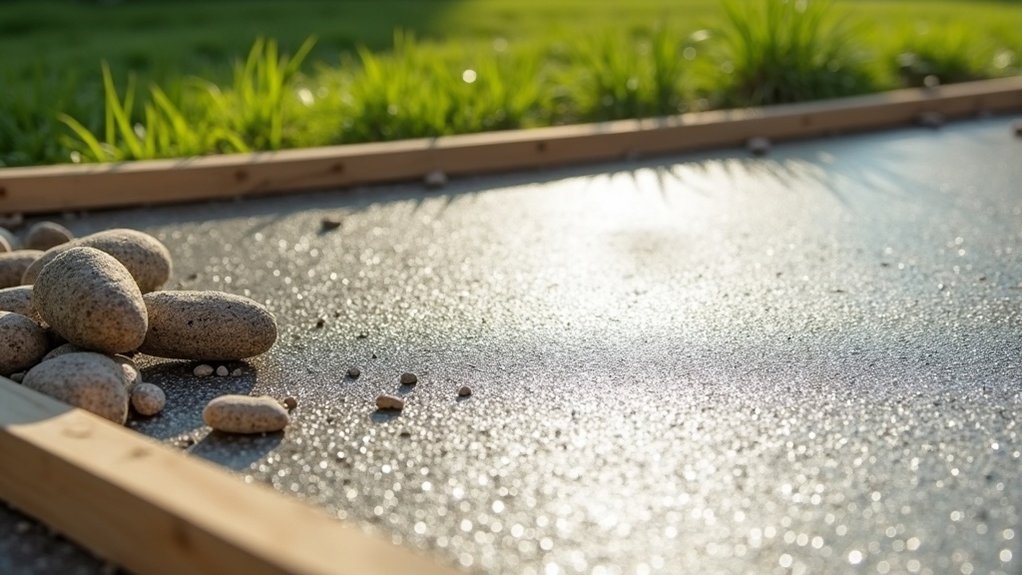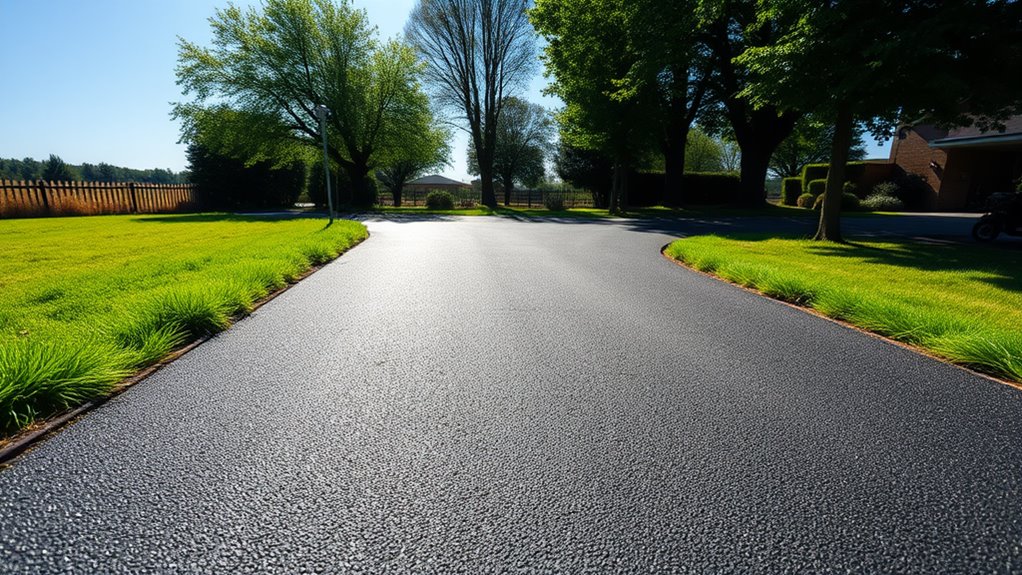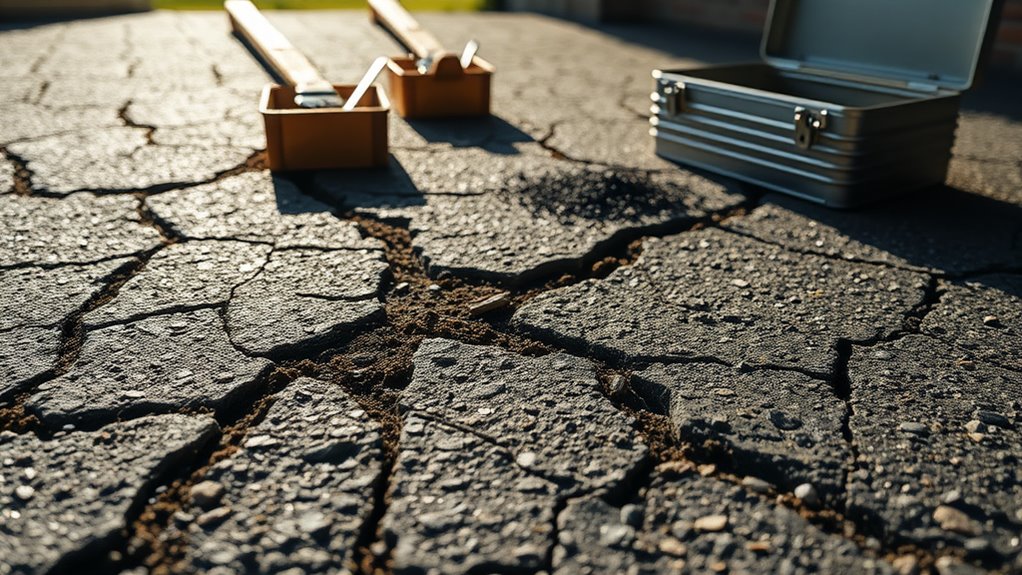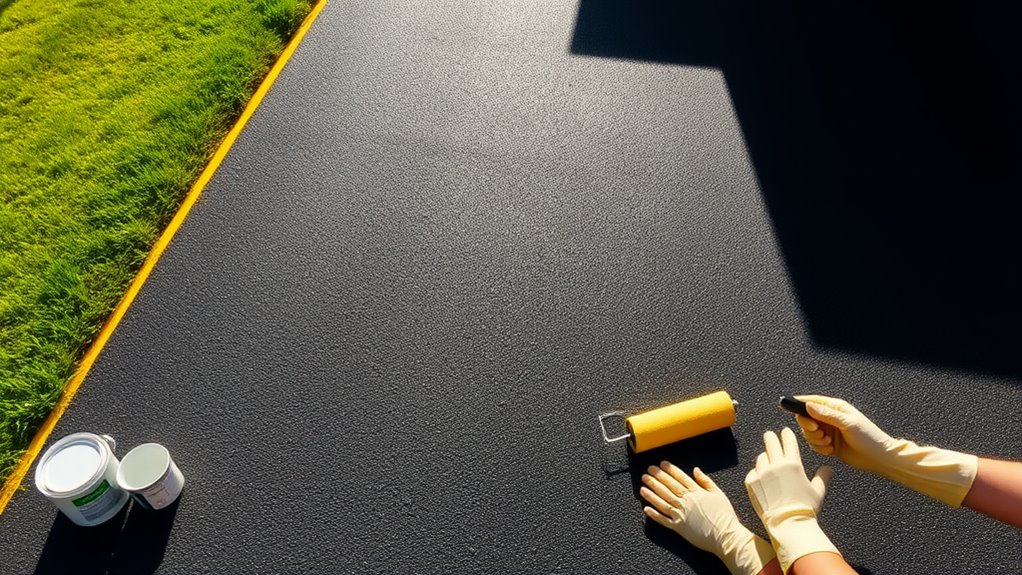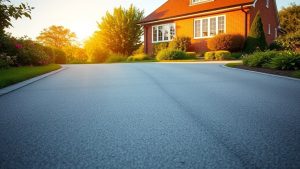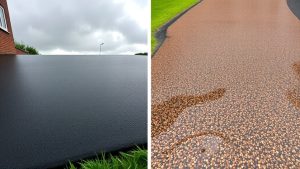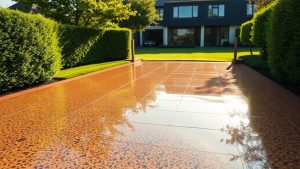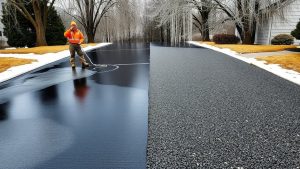To prevent your concrete driveway from settling and sinking, start with proper soil preparation and compaction to create a solid foundation. Install effective drainage systems to avoid water pooling. Seal any cracks and joints quickly to keep the surface intact. Manage plants and tree roots to reduce root intrusion. Regular maintenance, including inspections and cleaning, is essential. If you notice uneven areas, consider using techniques like mudjacking or polyurethane foam levelling to fill voids. These steps will help ensure long-term stability for your driveway.
Table of Contents
ToggleKey Takeaways
- Ensure proper soil preparation and compaction before laying concrete to create a solid base and prevent sinking.
- Install effective drainage systems to direct water away, minimising soil erosion around the driveway.
- Regularly check and maintain plants, keeping roots managed to prevent them from disrupting the ground beneath the driveway.
- Address cracks and joints quickly by sealing them to stop moisture from seeping in, which can cause settling.
- If sinking occurs, consider repair methods like mudjacking or polyurethane foam levelling tailored to the condition of the slab.
Proper Soil Preparation and Compaction
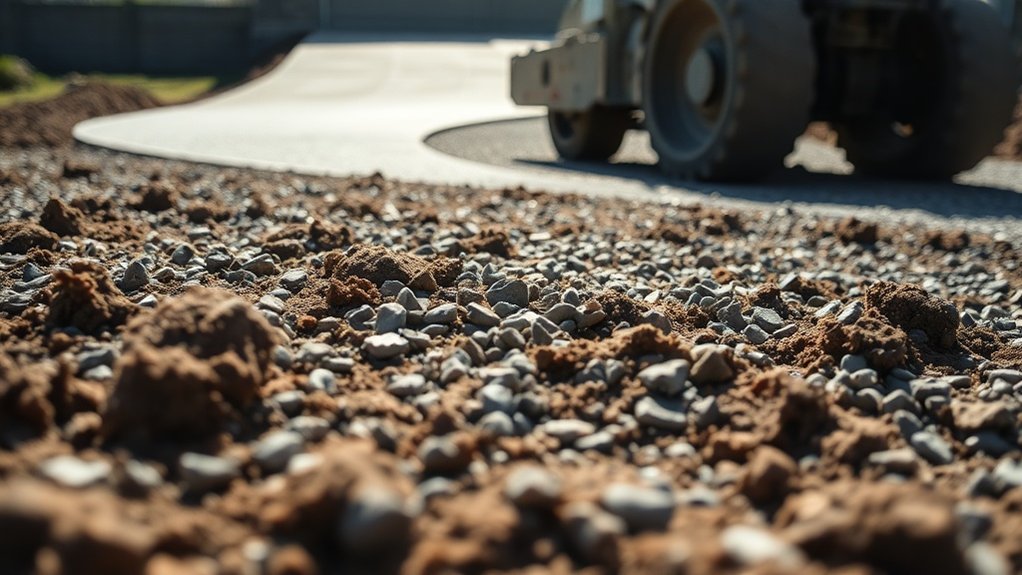
Proper soil preparation and compaction are essential to prevent settling in concrete driveways.
Start by clearing all vegetation, topsoil, and debris to establish a solid foundation. Excavate to a depth of 15 to 25 centimetres, ensuring a level surface for consistent concrete thickness.
Assess the soil type, especially if it’s expansive clay, and consider stabilisation if necessary. Use mechanical compactors to compact the soil in layers for optimal density. A well-prepared subgrade acts as a foundation for the concrete driveway, supporting its weight and stress.
Before compacting, check the soil moisture; overly dry or wet soil can hinder proper densification. Regularly test compaction levels to ensure they meet engineering standards.
Effective Drainage Systems
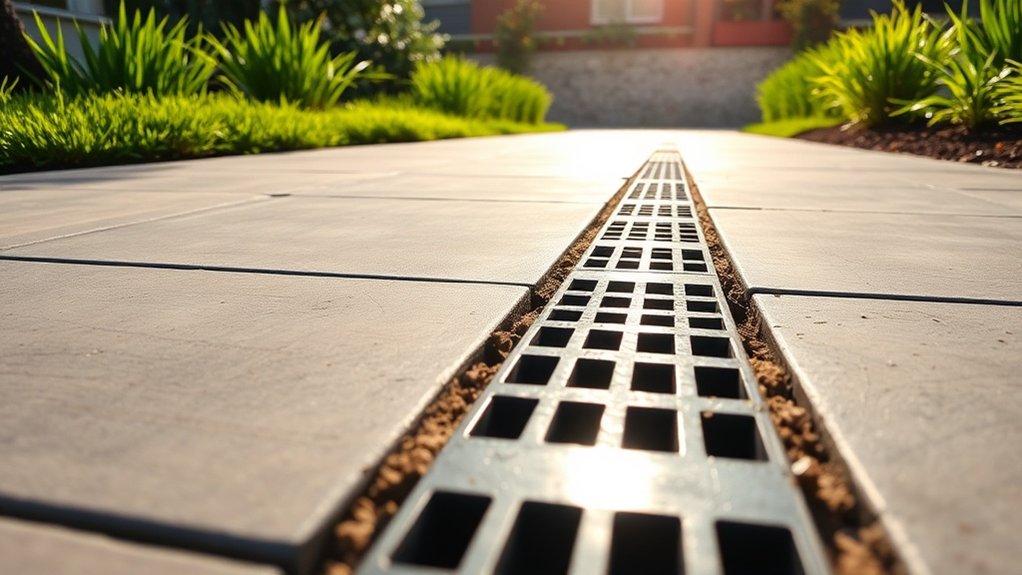
Effective drainage systems are crucial for preserving the integrity of your concrete driveway and preventing issues such as settling and erosion. Installing drainage solutions like trench drains or French drains helps to channel water away efficiently, reducing subsurface saturation. Aim for a slope of about 1% to direct water flow towards outlets. Opt for durable materials like cast iron grates or polymer concrete channels for managing moderate water flow. Driveway drainage systems are an essential investment that protects your property from water damage. Combining surface and subsurface systems improves overall water management, lowering groundwater pressure and preventing settling. Regular maintenance, such as clearing debris from grates and checking drainage slopes, is essential to ensure your system operates correctly and protects your driveway from water damage.
Crack, Joint, and Gap Sealing
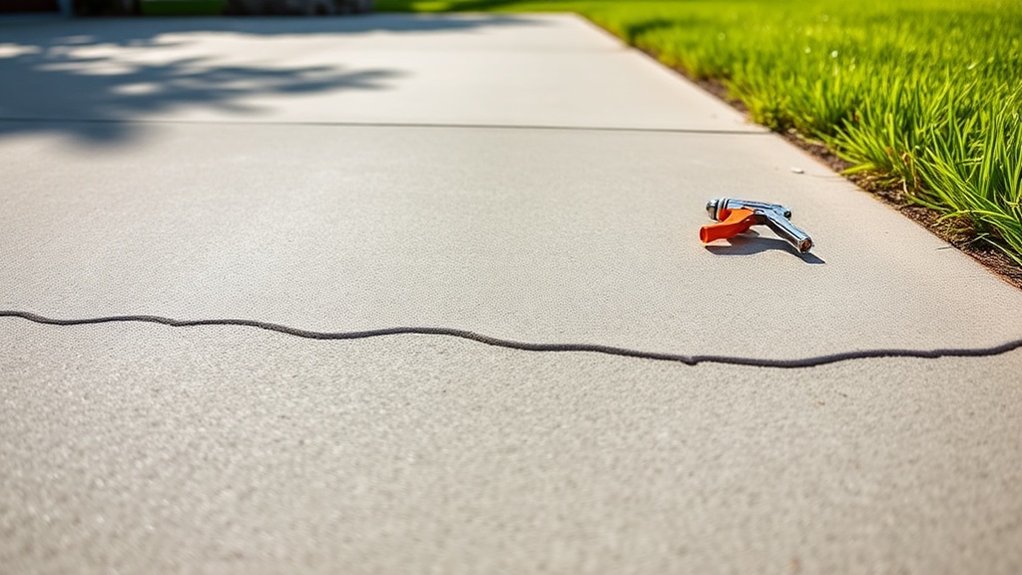
Sealing cracks, joints, and gaps in your concrete driveway improves its durability and prevents moisture from causing further damage. Begin by thoroughly cleaning the cracks to ensure proper adhesion. Choose the right sealant: epoxy fillers for structural needs, polyurethane for flexibility, or acrylic for areas without traffic. For wider cracks, use a backer rod for added support. Apply the sealant evenly with a 45° nozzle cut for precision. After application, smooth the surface to enhance adhesion. Regular maintenance is essential; check for shrinkage and reapply as necessary to maintain waterproofing and flexibility. Crack filling helps to prevent further damage by ensuring that moisture does not infiltrate the surface. Don’t forget to prioritize joint sealing to extend your driveway’s lifespan.
Manage Vegetation and Tree Roots
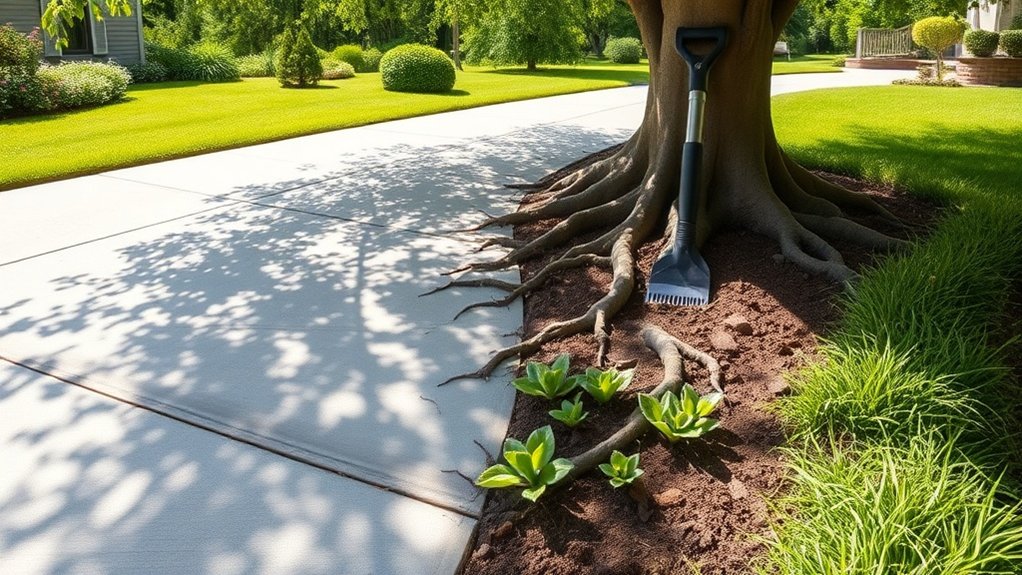
To manage vegetation and tree roots effectively, ensure planting distances are at least equal to the tree’s expected mature height.
Using root barriers can help redirect aggressive roots away from your driveway, reducing the risk of damage.
Regularly check the growth of plants to catch early signs of root intrusion before they cause serious issues with your driveway.
Safe Planting Distances
Managing safe planting distances is crucial to prevent root interference that can cause concrete driveways to settle or crack.
For small trees under 25 feet tall, such as Crape Myrtle or Eastern Redbud, plant them at least 6 to 10 feet away from the driveway edge.
Medium trees, like Dogwood or River Birch, should be positioned 10 to 20 feet away.
Large trees over 50 feet tall, such as the Southern Live Oak, need a minimum clearance of 20 feet.
Using proper planting techniques ensures that roots don’t disrupt the integrity of your driveway.
Root Barrier Use
Managing vegetation and tree roots is crucial for keeping your concrete driveway stable, and root barriers are key to preventing damage.
To install a root barrier, place robust plastic panels vertically underground, ideally 90 cm deep for larger trees. These barriers redirect roots, stopping them from pushing upwards and causing cracks or uneven surfaces.
Use interlocking root barrier materials for a secure fit, anchoring them with built-in ground locks. Position barriers alongside the driveway or around tree bases for maximum protection.
Before installation, remove any invasive roots to prevent regrowth. By effectively controlling root growth, you can significantly extend your driveway’s life and avoid expensive repairs due to root damage.
Monitor Vegetation Growth
Monitoring vegetation growth is crucial for maintaining the integrity of your concrete driveway. Regular visual inspections allow you to spot cracks and uneven surfaces near areas with plants.
To effectively evaluate root activity, consider these steps:
- Observe seasonal changes in plant density, which can suggest root expansion beneath the driveway.
- Occasionally utilise ground-penetrating radar for a non-invasive check to identify subsurface roots.
- Keep a record and map out nearby trees, prioritising monitoring based on the aggressiveness of their roots.
Proactive Maintenance and Inspections
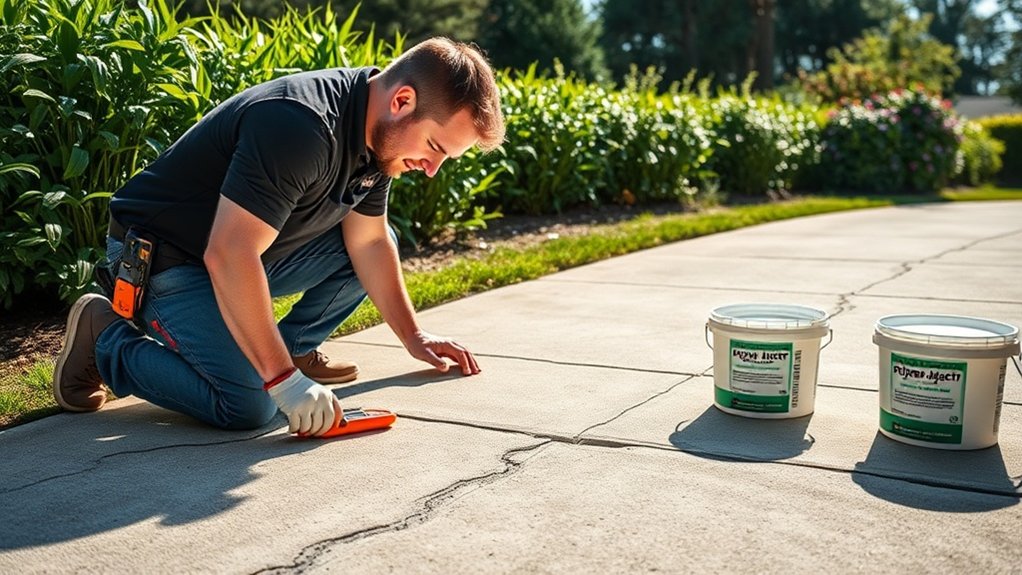
To effectively prevent settling in your concrete driveway, regular proactive maintenance and inspections are crucial. Aim to schedule annual inspections, preferably in spring or after heavy rainfall, to spot issues such as cracks, scaling, and discolouration. Keep a record of your findings to monitor changes over time and prioritise necessary repairs.
| Inspection Type | Key Indicators | Maintenance Action |
|---|---|---|
| Visual Inspection | Cracks, flaking, discolouration | Arrange repairs as needed |
| Surface Condition | Pitting, pooling, uneven areas | Evaluate and improve drainage |
| Cleaning & Debris Removal | Dirt, stains, snow | Regular cleaning and careful removal |
Void Filling Techniques
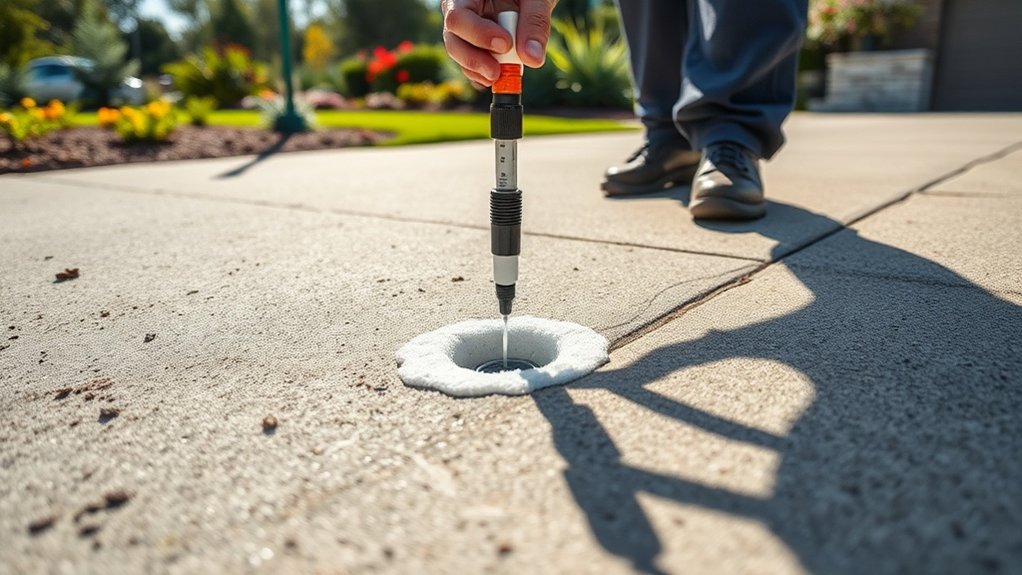
When tackling settling issues in your concrete driveway, two effective void filling techniques are Polyurethane Foam Injection and the traditional Mudjacking method.
Polyurethane foam is a rapid, clean option that causes minimal disruption, making it ideal for residential areas.
On the other hand, Mudjacking involves a slurry mixture, which can be more economical for larger surfaces.
Polyurethane Foam Injection
Polyurethane foam injection is a modern alternative to traditional methods like mudjacking, which often involve extensive excavation and prolonged downtime.
This method works by drilling holes into the concrete slab and injecting expanding foam to fill voids and raise the concrete. The foam cures quickly, usually within an hour, and its lightweight properties help reduce stress on the underlying soil.
Key benefits include:
- Minimal disruption to your garden and property.
- Durable support that withstands moisture and decay.
- Rapid return to use, making it perfect for busy households.
Mudjacking Method Explained
The mudjacking method is a popular technique for fixing settled concrete slabs. It involves injecting a specially formulated slurry beneath the surface.
The process begins with drilling holes of 1.5”-2” into the slab, allowing the slurry—a mix of water, soil, sand, and sometimes Portland cement—to be pumped in under high pressure. This fills any voids and lifts the slab back to its original position.
Mudjacking is cost-effective and can be completed quickly; however, it has its drawbacks. It won’t improve the surface appearance and may not be a long-term solution if the underlying soil is unstable.
It’s also less effective on thin or severely cracked slabs. Careful technique is crucial to avoid over-lifting, which can cause cracks in the concrete.
Concrete Raising Solutions
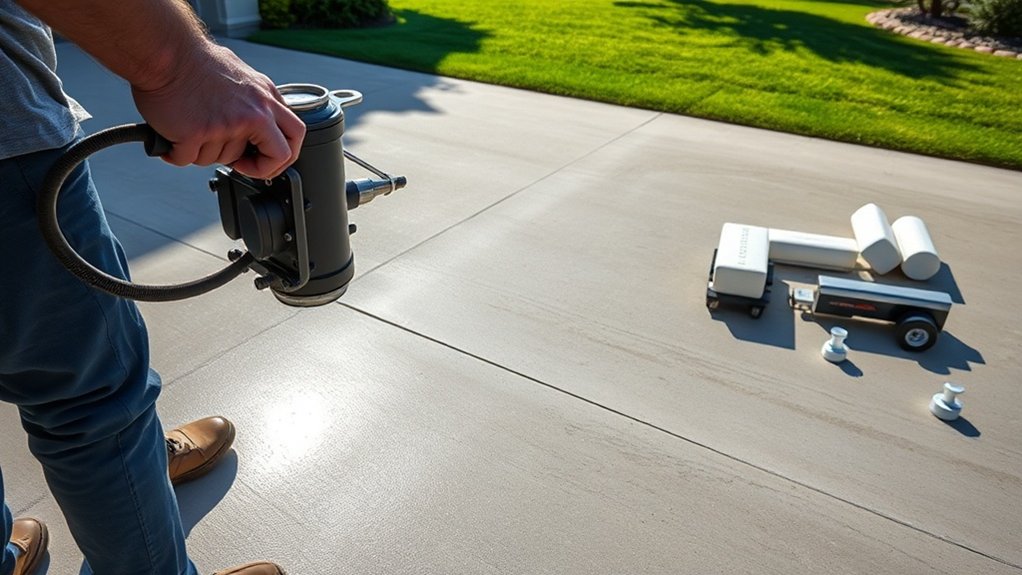
To effectively tackle settling issues in your concrete driveway, consider these concrete raising solutions that help restore stability and levelness:
1. Mudjacking: This method involves drilling holes and pumping a grout mixture beneath the slab to fill voids and lift it back into place.
It’s a cost-effective solution with minimal disruption to your driveway.
2. Polyurethane Foam Leveling: A lightweight foam is injected under the slab, which cures quickly and provides uniform lifting while reducing soil pressure.
This method is particularly efficient for smaller areas.
3. Stone Slurry Grout: This technique uses a mixture of crushed stone and grout that’s pumped beneath the slab.
It offers a robust lift, making it suitable for areas that bear heavier loads.
Each method has its advantages, so assess your specific needs and conditions to ensure you achieve the best outcome.
Frequently Asked Questions
How Long Does Concrete Typically Last Before Settling Occurs?
Concrete generally lasts between 25 to 30 years. However, issues related to settling, such as poor installation or inadequate drainage, can become apparent within the first 5 to 10 years if not addressed promptly. For example, if your driveway starts to crack or dip, it could be due to these underlying problems.
Can I Use Regular Soil for Driveway Installation?
No, you cannot use regular soil for driveway installation. It doesn’t provide the necessary compaction and stability. Instead, choose well-compacted gravel or crushed stone, which will create a solid and durable base for your driveway.
What Are Signs of Poor Drainage Affecting My Driveway?
When rain transforms your driveway into a mini lake, it’s a clear indication of poor drainage. Look out for cracks, pooling water, or signs of mould. These problems need prompt attention and effective drainage solutions to protect your investment.
How Can I Tell if My Driveway Needs Void Filling?
To find out if your driveway requires void filling, perform a quick assessment. Check for signs such as cracks, uneven surfaces, or hollow sounds when you tap the surface. Addressing these issues promptly can help prevent more serious damage down the line.
Are There Specific Plants to Avoid Near Concrete Driveways?
Avoid planting willows near your concrete driveway, as their invasive roots can exploit cracks, causing moisture absorption and damaging the slab. Opt for plants with non-aggressive roots to preserve the integrity of your driveway and avoid expensive repairs.
Conclusion
To stop your concrete driveway from settling and sinking, remember that “an ounce of prevention is worth a pound of cure.” Start with proper soil preparation and ensure effective drainage to avoid water pooling. Regularly seal any cracks, manage nearby vegetation, and conduct routine inspections. If problems do occur, consider void filling or concrete raising techniques to restore stability. Being proactive can save you time, money, and headaches in the future.
Maximize the durability of your tarmac driveway by understanding the ideal weather conditions for installation—discover the secrets to perfect timing Read more
Discover the common causes of tarmac driveway cracks and learn effective repair methods to protect your investment—your driveway deserves the Read more
Before you paint your tarmac driveway, discover essential tips and techniques that can transform its appearance and durability—don't miss out Read more

